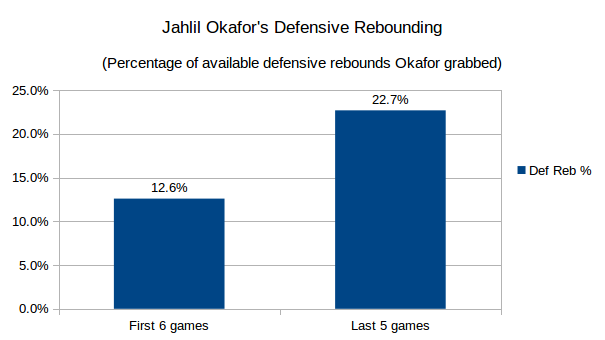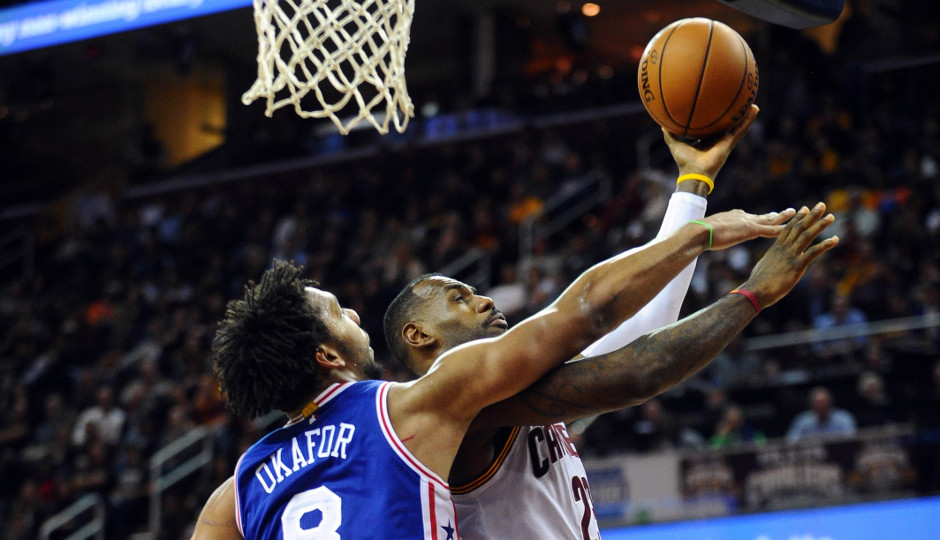Likes and Dislikes: Jahlil Okafor’s Improved Rebounding Big for 76ers
Each week we’ll dive into a couple of observations about the Philadelphia 76ers. You can view previous installments in the Likes and Dislikes series here.
This week we’ll once again focus on Jahlil Okafor. His improved defensive rebounding is a huge boon for a Sixers team that had to play without Nerlens Noel for a couple of games, but the perimeter shooters are currently letting him down.
Like: Jahlil Okafor’s improved defensive rebounding.
One of the areas of Jahlil Okafor’s game that came under scrutiny early in the season was his defensive rebounding, or lack thereof.
The criticism was warranted. Okafor was a mediocre defensive rebounder at Duke, something we noted in our pre-draft scouting report of him, hauling in just 18.2% of the available defensive rebounding opportunities while he was on the court. That only got worse to start his rookie season, where he pulled in a miserable 12.6% during the first six games of his NBA career.
When an injured wrist forced Nerlens Noel to miss two games the Sixers needed Okafor to step up and fill the void. And while Okafor hasn’t quite replaced Noel’s rebounding, he did improve significantly over his meager rebounding output to start the season.
Okafor’s defensive rebounding rate over the last five games is 22.7%, much more in line with the expected production of a big man who hangs around the basket most of the time. More importantly, the team is rebounding better, collecting 74% of the defensive rebounding opportunities with Okafor in the game, compared to just 68.8% when he’s been on the bench during that span.

Jahlil Okafor’s defensive rebounding rate. Data through November 17th, 2015. All data courtesy nba.com/stats
We talk a lot about sample size, and four games certainly isn’t enough to quell any concerns. But the effort seems to have been better from Okafor of late, and it’s a good sign going forward. If Okafor is going to overcome some his question marks on the defensive side of the court, being a force on the defensive glass is likely to be necessary.
Dislike: Three point shooting woes
The 76ers *want* to be a good three point shooting team. They ranked 5th in the league in three point attempt rate last season, which is what percentage of field goal attempts that come from behind the three point line. They did this despite not necessarily having guys who could make the shot: their 32% placed them at 29th in the league.
The value of the three point attempt is a staple of the “analytics movement”, with Hinkie’s former team, the Houston Rockets, having led the league in three point attempt rate in each of the past three seasons. Before that they came in second in 2012-13. Slackers.
Unlike last season, the Sixers are starting to have the pieces to be successful from long range. Jahlil Okafor is already commanding double teams in the post regularly only eleven games into his NBA career. And the Sixers should, in theory, have more people capable of making these shots, as they added Nik Stauskas’ shooting to go along with Hollis Thompson, Robert Covington, and Isaiah Canaan.
And that theory is starting to play out. 23.5% of the Sixers field goal attempts come from beyond the three point line with the nearest defender is 4 feet or more away from the shooter, according to nba.com/stats. That places them in the top half in the league, a pretty incredible accomplishment for a team that only has one shot creator and doesn’t have the benefit of playing at the same pace they were able to the previous two seasons.
The problem? They don’t make them. The 34.3% they shoot on these open three’s is below the league average, although at 19th in the league not as bad as one might expect, and a slight improvement over the 33.0% they shot last year.
I would expect both of these numbers to climb, which would have a huge positive impact on the Sixers half court offense. It should lead to improved floor spacing, cut down on turnovers, and cause Okafor to see less double teams, which should help his own individual efficiency. I think the team will get more open looks as they learn how to play off of Okafor, and I think they’ll start making more of these open looks as Stauskas, Thompson (who started off ice cold from three point range), and Canaan (who is already starting to turn it around) return to form, and as Robert Covington gets back into a rhythm after missing nine of the first ten games due to injury.
| Player | 3pt% (closest defender 4+ feet away) |
|---|---|
| Nik Stauskas | 28.8% |
| 2014-15 NBA Average | 36.3% |
(To illustrate how much impact a guy like Covington can have on these percentages: last year Covington shot 39.3% on shots where the closest defender was 4+ feet away, making 119 of the Sixers 577 such three pointers. The Sixers outside of Covington shot just 31.7% on three pointers with 4+ feet of space).
One area that could help in this regard is to get more corner three point attempts. Last year’s team shot 38.7% from the short corner, well above the league average of 35% on three point attempts overall. But this year’s Sixers squad attempts just 18.1% of their three point attempts from the corner, which ranks 26th in the league.
Again, this is an improvement over last year, where they ranked 29th in the frequency of corner three point attempts, but this is something that I feel like could be improved upon, especially with Okafor’s ability to command a double team and now with T. J. McConnell, and his ability to probe the defense, getting consistent playing time.
With good scheme and ball rotation, the Sixers should be able to get more three’s from this area of the court. I’d also like to see the Sixers use their big men to set more screens, perhaps running more hammer-type sets that Brown brought with him from San Antonio, to get shooters open looks in the corner. This facet of the game just be limited because of the fact that so many of the big men are new to the team.
Derek Bodner covers the 76ers for Philadelphia magazine’s new Sixers Post. Follow @DerekBodnerNBA on Twitter.



